Today was a long, but fruitful day of working out at our drilling site. Since we previously had a few problems with the poor weather and the drill malfunctioning, we decided to make up for some of the lost time today. We headed out at 8:00 AM and worked through until 6:00 PM. The weather was perfect for drilling ice core samples – it was about 0 degrees Fahrenheit most of the day (though it was -8 degrees when we left) and the winds were light.
Surprisingly, I wasn't really cold at all. The main thing I had to look out for was the sun on exposed skin (i.e. - my face). Since we are at such a high altitude, the sun's rays are quite strong up here. Additionally, the light reflects off the snow and that can give you a sunburn as well. But, it was nothing that some SPF 50 sunscreen can't protect against!
Once we got to the station, we spent a few minutes getting ready for the day's activities. Since we were expecting to get quite a few samples, we knew that the storage pit we dug yesterday wasn't going to be sufficient. We ended up digging a much larger pit to hold the day's core samples. While the science team was doing this, the drillers were getting the drill ready for action.
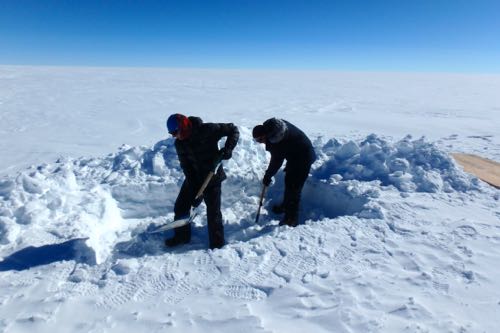 Researcher Eric Wagner and PolarTREC teacher Steve Kirsche dig a pit to hold the core samples and keep them cold enough.
Researcher Eric Wagner and PolarTREC teacher Steve Kirsche dig a pit to hold the core samples and keep them cold enough.
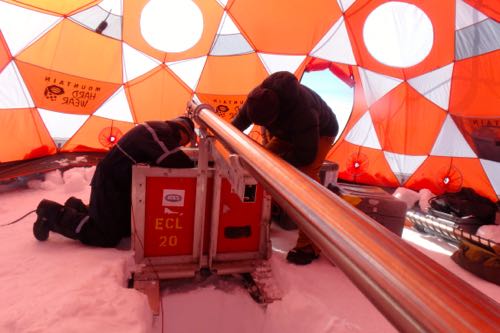 Professional drillers Mike Jayred and Elizabeth Morton prepare the drill for a long day of drilling core samples.
Professional drillers Mike Jayred and Elizabeth Morton prepare the drill for a long day of drilling core samples.
Once that was completed, we set to work collecting samples. The drillers run the machine that cuts the core sample and then passes it along to the research team. Each core goes through the following steps:
- The drill itself is hollow. So, as it drills down, the core sample is collected inside the drill. Once the desired depth is reached, the core is broken off and the drill is retrieved. The drill barrel is then brought out to the research team. A long tool is used to push the core out of the barrel onto a table where it can be processed.
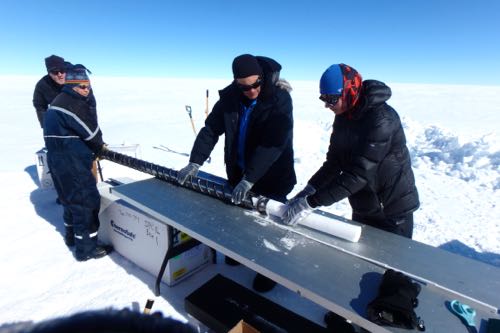 Researcher Eric Wagner and PolarTREC teacher Steve Kirsche receive the core sample from the drill.
Researcher Eric Wagner and PolarTREC teacher Steve Kirsche receive the core sample from the drill.
- Once the core has been pushed out of the barrel of the drill, the drillers go back to work on retrieving the next sample. The research team then begins the process of documenting the sample and preparing it for transport. First the length of the sample is measured and recorded. This is a crucial step because when scientists examine the samples back in the lab, they need to know from what depth it was retrieved.
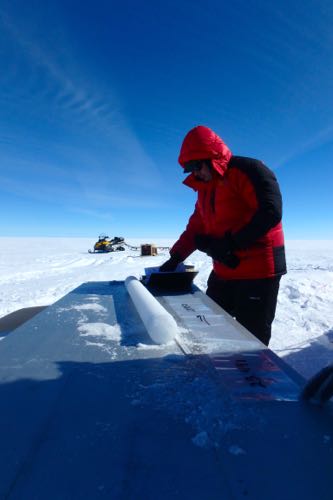 Researcher Ian Baker logs each core sample to keep track of what depth each sample was retrieved from.
Researcher Ian Baker logs each core sample to keep track of what depth each sample was retrieved from.
- Once it has been logged, it is placed in a plastic bag. The depth of the top of the core and the depth of the bottom of the core are marked on the bag. An arrow is also put on the back indicating which end is the top. After being bagged, it is placed in an insulated cardboard tube for more protection.
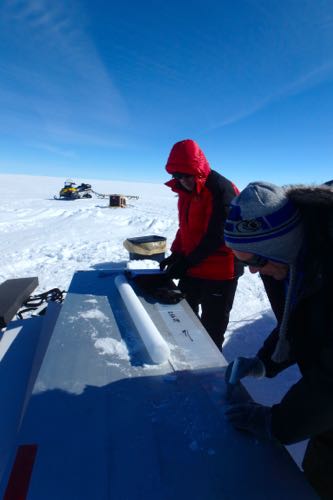 PolarTREC teacher Steve Kirsche marks a plastic bag that will help protect the sample while it is stored and transported.
PolarTREC teacher Steve Kirsche marks a plastic bag that will help protect the sample while it is stored and transported.
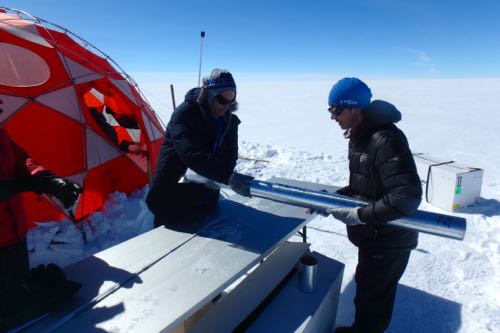 Researcher Eric Wagner and PolarTREC teacher Steve Kirsche place a bagged core sample into an insulated tube for transporting back to Dartmouth College.
Researcher Eric Wagner and PolarTREC teacher Steve Kirsche place a bagged core sample into an insulated tube for transporting back to Dartmouth College.
- The tube with the sample is placed in an insulated box. This box will hold about six samples. It is also filled with snow and eutectics (a fancy scientific name for cold packs). The box of samples is labelled and stored for transport back to the lab. It will be kept at or below -20 degrees Celsius throughout its journey back to the United States. The reason it has to be kept so cold is that that is the temperature it was within the ice sheet. If it is exposed to higher temperatures, the structure of the ice could change.
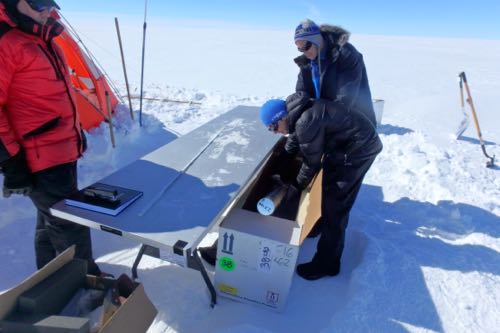 The box that the sample is placed in is heavily insulated to keep the cores at the appropriate temperature.
The box that the sample is placed in is heavily insulated to keep the cores at the appropriate temperature.
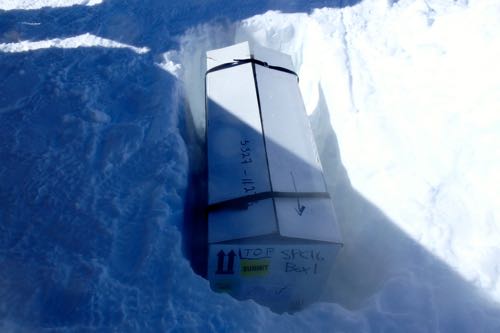 The box of core samples is stored in an underground pit to keep its temperature low. This is necessary even though the air temperature was 0 degrees Fahrenheit.
The box of core samples is stored in an underground pit to keep its temperature low. This is necessary even though the air temperature was 0 degrees Fahrenheit.
These steps were repeated many times today. Each core sample is approximately 1 meter long and the team was able to collect about 33 meters of samples today (that is a very good day of drilling). The only real break we took was when we all went into the shelter tent to eat lunch. All in all, it was a tiring, but very good day of doing science in the Arctic!
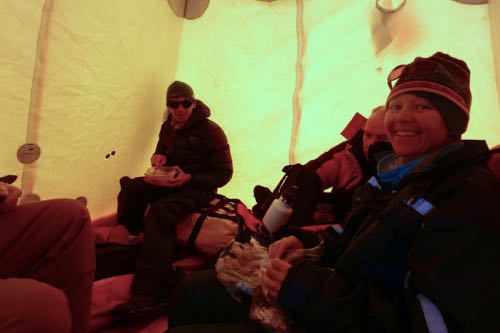 The team gets a respite from the cold in its shelter tent to eat lunch. (Pictured from left to right: Eric Wagner, Ian Baker, Elizabeth Morton)
The team gets a respite from the cold in its shelter tent to eat lunch. (Pictured from left to right: Eric Wagner, Ian Baker, Elizabeth Morton)
Video from a Couple of Days Ago
This video shows a little bit of the weather that we experienced a couple of days ago. It stopped us from going out to our drilling site.
Polar Profile
Name: Danny
Job Title: Construction Field Coordinator
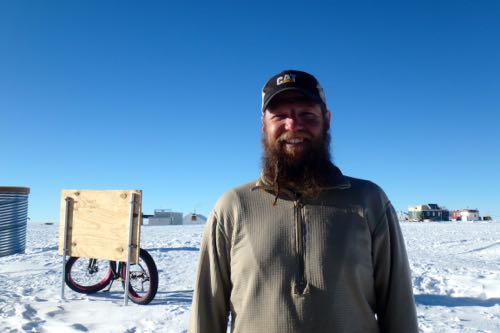 Danny is the construction field coordinator at Summit Station, Greenland.
Danny is the construction field coordinator at Summit Station, Greenland.
Home: Winthrop, WA
Length of Time Working in Polar Regions: Danny has worked in both the Arctic and Antarctic since 2007.
Length of Current Assignment to Summit Station: Danny arrived in April and will be on station until the end of June.
Job Description: Danny completes different construction projects. He also runs much of the construction equipment. He is in charge of supplies and materials for the construction workers that are on site and is in charge of the waste that leaves the station.
Favorite Part of Working at Summit Station: Danny says that his favorite part of working at Summit Station is the community. His coworkers are great.
Hardest Part of Working at Summit Station: Danny says that the hardest part is the fact that there is a fairly regular routine. He misses the variety in routine that he gets when at home.
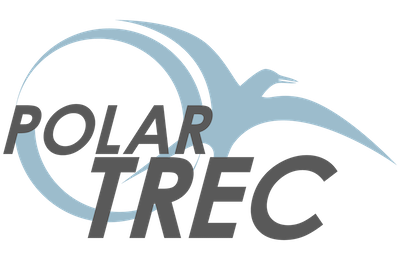

Comments
Add new comment